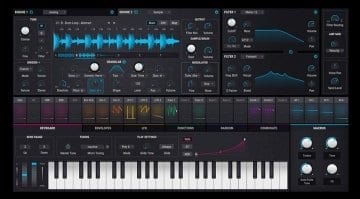Arturia Pigments: a swirling polyrhythmic, modulating and randomising mega-synth
This is where Arturia has been heading all this time. After 20 years of emulating synths from across the decades they’ve pooled all that experience into Pigments, a visually enticing mega-synth that takes modulation, randomisation and probability to some very interesting places.
Pigments
Well, I was right about it being a super duper software synth. Pigments combines a big wavetable synthesizer with all the virtual analog stuff they’ve been doing all this time. Arturia says that it can sound like other synths (for sure) but no other synth can sound like Pigments. It’s a bold statement in an era where we are awash with awesome synthesis with more fabulous sounding presets than we would ever have the time to try. However, Pigments has some tricks up its sleeves and a powerful way of tackling the complexity of modulation that makes the workflow really quite exciting.
The Main Page
It has 2 sound engines that you run together in parallel. These can be set to Wavetable or Analog.
On the Wavetable side there are loads and loads of wavetables for you to play with. You can then morph or step through the position, build up voices of unison in classic or chord modes and then totally mess with the waveform via FM, Phase Modulation, Phase Distortion and Wave Folding. Not sure what they do? Don’t worry, just turn up the amount and enjoy the sound and the movement in the neon style waveform display.
On the analog side you have 3 oscillators with our regular 4 waveforms of sine, triangle, saw and pulse, with width modulation. You can tune and mix the oscillators independently and even throw in some tuning drift to keep things authentic.
There are 8 filter models covering all the sorts of filters Arturia has encountered in their travels. There’s the SEM, Mini, Matrix 12, Surgeon, Comb, Phaser, Formant and Multimode. You can run two filters together in various routings.
That’s the top half of the screen, the bottom half is all about modulation. You can use pretty much everything to modulate anything. There are 3 regular LFOs but there are also 3 function generators, 3 envelopes, you can tie in velocity, expression, keyboard and aftertouch. If that’s not interesting enough then how about combining a couple of modulators to form some new and slightly bonkers ones? Or sod all that and go with randomisation. Choose from Turing, Sample & Hold or Binary for all your random needs. And what’s brilliant about the modulation section is how wonderfully it’s visualised. Whatever’s going on is always on show and animated and you can get in and edit every aspect of whatever modulation engine suits your purpose.
Rounding off the main page are 4 Macro knobs which you can assign to any combination of parameters.
Effects
Two insert busses and a send bus each with 3 inserts form the overly comprehensive effects section. Choose from 14 of the usual effects (including a good bit of wavefolding and bitcrushing) to fill up to 9 slots and process the heck out of your sound.
Sequencer
And rounding it all off is the visually dull but awesomely powerful arpeggiator/sequencer. 16 steps with 6 tracks covering pitch, octave, velocity, trigger probability, gate length and slide. This is where the randomisation engine really makes its mark. Each track can have a level of randomisation set. You can then manually roll the dice to get a bunch of random values (scaled by the set level) or it’s even more fun to select a re-trigger cycle that throws in a bunch of new values every bar, or half bar or eighth bar. Very quickly you can build up some very interesting evolving rhythms and variations. But then you can enable polyrhythms and start having each track running to its own length and timing. It’s a fascinating place to play, I just wish it was more interesting to look at in an otherwise brilliantly visual synthesizer.
Advanced Software Synthesizer
Yeah, it’s pretty advanced, but fun too. The sounds are excellent but it’s all that modulation and easy-to-implement randomisation that makes Pigment a lot of fun to play with.
Until 10th January 2019 you can try Pigment for free. Or you can buy it for $149 and then it’s $199 after that. Upgrade options for V Collection users will become available..
More information
Video
You are currently viewing a placeholder content from YouTube. To access the actual content, click the button below. Please note that doing so will share data with third-party providers.
 4,0 / 5,0 |
4,0 / 5,0 | 









